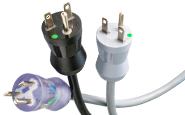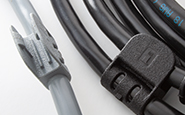PHONE: U.S. (641) 673-5000 | Toll-Free: (800) 662-2290 | UK +44 (0)1908 295300 | Freephone: 00800 5566 5566

Specifying the Correct Fuses for International ApplicationsOne of the most important aspects of international equipment design is the incorporation of circuit protection into the equipment, in order to protect both the equipment and the end user in the event of an over-current fault condition. Arguably the most common, easiest, and most inexpensive ways of achieving this is the use of fusing in the equipment. However, it isn't as simple as inserting a fuse into the equipment and shipping it anywhere in the world. In this issue of Connections, we will discuss the different fuse standards used in the world, the different physical sizes of fuses most commonly used, and other considerations that need to be made when selecting the correct fuse for your application.Fuse Standards and their DifferencesFuse requirements in the United States and Canada are found in the standards UL 198G and CSA 22.2 No. 59-1972. These standards cover two different fuse sizes for equipment, commonly used in North America: the common 1/4" x 1 1/4" fuse and an increasingly popular 5x20mm size fuse. Fuse requirements for most of the rest of the world originate from the standard IEC 60127. These fuses come in a 5x20mm size, but are different from the North American fuses in key ways. Therefore, it is very important when designing equipment for both North America and export to other nations, to identify and source the proper fuses for the correct locations. This may require you to carry two separate fuses in inventory in order to have the correct fuses available for the locations to where the equipment will be shipped. It is not recommended to try and use a North American fuse in other countries, or the IEC fuse in North America because of the differences in the fuse standards and the difficulties the end user will have in finding the correct fuse replacement. In some cases, there is some overlap in the requirements, and therefore there are a few fuses (in a limited number of sizes) on the market that will carry approvals and meet the requirements for both standards. However, for the most part you will find this is not the case. Fuses for North America can be identified by UL listing or recognition and CSA certification. For international fuses, look for an international approval agency mark, such as from VDE, SEMKO, CCC or some other similar agency, or in the absence of approvals look for reference to the IEC 60127 standard on the packaging or data sheets (Note: International approval agencies only approve fuses up to 6.3A because that is as far as the standard covers; fuses above this rating are available, but without approvals, even though the meet the basic standard requirements).As mentioned, there are a few key differences between North American and international fuses. The most important is the time-current or clearing time characteristic of the fuses. This refers to the speed that a fuse will blow under certain over-current conditions. UL and CSA specify that a fuse must not open or blow, with load conditions less than 110% of the rated current. The IEC 60127 standard requires fuses to withstand currents of 120% of the rated current for a minimum of 100 cycles. The standard defines a cycle as the product being on for one hour, off for 15 minutes, followed by one hour at 150% of rated current.Another difference is how the fuses are classified by the standards. UL and CSA have two classes of fuses: fast-acting and time-delay. The IEC standard goes a step further and breaks the fuses into four classes known as Sheet Styles, which includes the speed descriptor plus a breaking capacity identifier. Sheet I fuses are Quick-Acting, High breaking capacity; Sheet II fuses are Quick-Acting, Low breaking capacity; Sheet III are Time-Lag, Low breaking capacity; and Sheet V are Time-Lag, High breaking capacity.Time-Delay and Time-Lag are fuse types that do not blow immediately when a small or brief over-current occurs. This is a way of lessening nuisance tripping situations. Fast-Acting and Quick-Acting are fuse types that will immediately open once the current crosses the regulated threshold. These fuse types are designed to open extremely fast in order to protect very sensitive equipment from damage by an over-current event.A third difference between the fuse standards was mentioned briefly in the last paragraph, which is breaking capacity. Breaking capacity refers to the fuses ability to clear a fault condition without being destroyed and is expressed in amperes. The IEC 60127 standard categorizes breaking capacity as either high or low. The UL and CSA standards list specified breaking capacity values for various fuse rating combinations. While some are high values and others are not, there is no real official categorization, although high breaking capacity fuses are usually quite recognizable. High breaking capacity fuses, under both standards, are typically made of a ceramic material (although glass can be used) and the tubes are filled with sand. This prevents the fuse cylinder from shattering and spreading debris throughout the equipment or inside the fuse holder.Steps in Specifying a FuseWhen specifying fuses for an application there are three objectives that need to be met: protect the operator of the equipment, protect the equipment itself, and avoid nuisance tripping or opening of the fuse. By following the basic steps in this section, you will be able to successfully determine what fuses you need to source.1) Verify where the equipment is going to be sold. As mentioned above, there are different standards and approval requirements that need to be met.2) Based upon the surge current characteristics of the product, determine the correct type of fuse needed. If the product includes motors, transformers, incandescent lamps or other large inductive sub-systems, then a large in-rush current may be expected. In-rush current is an extremely fast spike of current that occurs when a device is turned on and components need energized or inertia must be overcome. In-rush currents can require Fast or Quick-acting fuses to be sized 1.5 to 3 times the full load current value. Even then, nuisance openings may still be a problem. Time delay or time-lag fuses are more appropriate in this situation. With these types, the fuse only needs to be sized 1.25 to 1.5 times the full load current and the built in delay will stop nuisance openings from occurring.3) Select a current rating and clearing time characteristic that you feel is appropriate for your product. Components such as semiconductors, resistors, transformers, or heat elements can overheat dangerously. Use the manufacturers' specified overload current ratings of these components to assist you in the selection process. The selected fuse value must be lower than the lowest overload current value of the components in the system. The nominal current rating, or "steady-state current", of a product is an indicator of the average current draw of a device under normal operating conditions. This will allow you to determine a likely current level for your fuse selection. In an application where the current is dynamic and changes often with the switching on and off of circuits, motors, or sub-systems it is advisable to again choose a fuse rating that is at least 1.25 to 1.5 times the full load current. Ideally the fuse value you select should be between the component overload current value and the full load current. Other factors such as clip retention force on the end caps, wire size, and ambient temperature could cause variations that require you to adjust the rating of the fuse higher yet. It is always advisable that once your final fuse selection is made on paper, to obtain samples of that fuse and several others with ratings just above or just below, and possibly with different characteristics, in order to test them in your product to ensure that nuisance opening is not a problem. Remember, a time lag type fuse is good for curing these nuisance opening issues, but a fast acting fuse may be more important to protect sensitive devices.4) Select the appropriate voltage rating for the fuse. The safety agencies covering the various standards have developed voltage ratings for the various types of fuses. The key to remember here is to simply make sure the voltage rating of the fuse is greater than or equal to the line voltage in the location the fuse is used.5) Select an appropriate breaking capacity for the fuse you wish to use. Verify that the fuse you are considering has greater breaking capacity than the maximum available current that could be supplied to your product. If the breaking capacity is too low, the fuse could explode during a fault and cause damage to the equipment or injury to the user of your product. High breaking capacity fuses can handle a lot larger fault current without being destroyed. As described earlier, this is because of the ceramic tube that is often used and the fact that the tubes are sand filled to absorb the concussive force of larger fault currents forcing the fuse to open.6) Determine the size fuses you want to use. This decision will affect other component selection such as modules, fuse carriers and holders, or fuse clips and blocks. These items must be capable of accepting the fuse size you choose. If you are just selling in North America, you might want to just stick to the 1/4 x 1 1/4" fuses that are well known, although, you could opt for a 5x20mm version. Equipment that is strictly for export overseas will need a 5x20mm fuse. If you are a manufacturer that sells equipment in both North America and other locations in the world, it is recommended you consider using the 5x20mm size across the board. This will allow you to select modules, fuse holders and carriers, or other related fuse accessories for one single fuse size, which will help with inventory and overhead. Keep in mind, you still may have to source two different fuses, especially if your equipment runs on 120V in North America and 230V elsewhere. This is because at 230V the equipment will only draw about half the amperage that it would in North America at 120V. Therefore two different fuses with different amperage ratings would be required.7) Finally, get samples of the fuses you think will work for you, as well as several fuses in the general vicinity. Choosing a fuse is not always an exact science and other factors of your product may dictate that you slightly increase or decrease the fuse size. You may also decide to switch clearing time characteristics or breaking capacity levels. Only by running in-house testing, can you be certain that the fuses will work as you hope and that you meet the objectives of fusing and circuit protection.Understanding the differences in fuses and the considerations involved in choosing a fuse is essential in final product design. By observing the guidelines and tips here, while considering the variables that are created by your product and may affect fuse selection, you should now have a much easier time specifying fuses for you applications.




